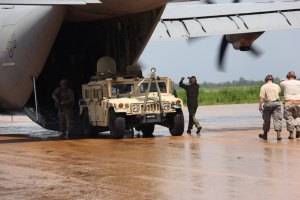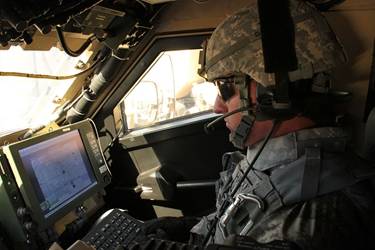
The Warfighter Information Network-Tactical (WIN-T) Tactical Communications Node-Lite, like the one seen here during a developmental test at Fort Campbell, Kentucky, in mid-December 2016, provides satellite and line-of-sight network connectivity, both on-the-move in a convoy, at the quick halt, and to the stationary command post, enabling mission command and advanced communications. (Photo Credit: U.S. Army)
FORT CAMPBELL, Ky. Jan. 23, 2017. — In support of expeditionary, quick reaction and air assault missions, the Army is testing significantly lighter versions of two configurations of its mobile tactical communications network known as Warfighter Information Network-Tactical (WIN-T).
“From a warfighting perspective, these light network vehicle configurations are extremely critical to how we want to fight as a brigade,” said Col. Alan Boyer, commander for the 1st Brigade Combat Team (BCT), 101st Airborne (Air Assault) Division, or 1/101 ABN Div, which supported the recent developmental test of these capabilities. “We need to be smaller, more mobile and agile, for both force protection and readiness, as we fight potential near-peer adversaries.”
The 1/101 ABN Div provides joint forcible entry capability through heliborne air assault operations. It is regionally aligned to support U.S. Africa Command and must simultaneously maintain readiness via U.S. Army Forces Command to rapidly support other missions worldwide, with little or no notice.
Until now, the unit’s WIN-T Tactical Communications Node (TCN) and the Network Operations and Security Center (NOSC) have been delivered on five-ton Family of Medium Tactical Vehicles (FMTVs), but the new Lite (L) versions are integrated onto Humvees, which can be sling-loaded from a helicopter for significantly increased agility and operational flexibility.
The TCN provides satellite and line-of-sight network connectivity, both on-the-move in a convoy, at the quick halt, and to the stationary command post, enabling mission command and advanced communications. The NOSC is used to monitor, manage and provide enhanced security to the entire WIN-T network. The Lite versions of these configurations provide the same networking and network management capabilities as their much larger predecessors, with significantly reduced system complexity.
“We are the world’s only air assault division, and we are very good with helicopters,” Boyer said. “From a tactical perspective, my ability to conduct mission command in an austere environment like Africa absolutely requires capabilities that are lighter, and aircraft and helicopter air assaultable.”

The Army is providing lighter weight, more transportable configurations of its tactical communications network backbone, WIN-T, including air transportable HMMWVs like the one used here. (Photo Credit: U.S. Army, PEO C3T)
With support from 1/101 ABN Div, the Army successfully completed the second of two WIN-T Increment 2 TCN-L/NOSC-L developmental tests at Fort Campbell in mid-December, to gain Soldier feedback through the execution of operational vignettes. Additionally, during the event the Army successfully demonstrated the seamless interoperability between the TCN-L and other network communication capabilities including the inflatable Transportable Tactical Command Communication (T2C2) ground satellite terminal. The TCN-L/NOSC-L developmental test reduced risk for the upcoming operational test scheduled for Network Integration Evaluation 17.2 in July 2017. The 2nd BCT of the 101st ABN Div will support that operational test, which will aid in the Army’s quest to provide a more expeditionary network and force.
“As an air assault unit, having an expeditionary network gives us a tactical edge when going into environments that are not safe,” said Sgt. Michael Riffey, Network Operations S6 (signal officer) non-commissioned officer for the 1/101st ABN Div. “We can drop in behind enemy lines and set up camp in enemy territory a lot easier…without getting blown up trying to drive in.”
Before the Humvee integration of the TCN and NOSC, the Army had already integrated and fielded the WIN-T Point of Presence (provides on-the-move mission command) and Soldier Network Extension (provides satellite and line-of-sight communication, and radio network extension) onto Humvees, and now it has applied those lessons learned to the TCN and the NOSC. In a large part, these size, weight and power (SWaP) reductions were made possible through the software virtualization of hardware components.
“One of the main features of the TCN-Lite and NOSC-Lite is that the Army virtualized some of the components into one system that can be commercial-off-the-shelf swappable, so it reduces the system’s operational risk profile — fewer moving parts makes for a more reliable system,” said Maj. Aaron Fletcher, 1/101 ABN Div S6. “That feature of course makes it lighter, but it also makes it much quicker to start up and shut down. The Army is definably moving in the right direction with the virtualization of the tools put on these platforms.”
The Army also reduced system complexity by extending the same kiosk-based user interface and automated troubleshooting tool approach it used for the PoP and SNE to simplify both the legacy and lite versions of the TCN and NOSC.
“We have also upgraded the server and computing power on the system itself, so even though it’s in a smaller package, it is a far more powerful system than what is in the field right now,” said Lt. Col. Michael Williams, product manager for mobile WIN-T Increment 2. “We also tech inserted Network Operations (NetOps) improvements to simplify network management. Together these improvements result in a significantly better user experience.”
As the Army’s unified tactical communications network, WIN-T enables mission command, robust communications and situational awareness both at-the-halt and on-the-move. It delivers a satellite and line-of-sight modular “tool kit” of network connectivity that enables commanders to access mission command applications that best support their mission at every stage of operations. The Army is working to expand this tool kit with more expeditionary line-of-sight and satellite network communications capabilities to successfully support strategic priorities for readiness, responsiveness and regional engagement.
“As part of the 101st Air Assault, we are a self-contained mobile asset that can go far and deep and fast, which is why we have been begging for light communications systems that can keep up with the way we want to fight,” Boyer said. “It would be so much easier to fly a TCN-Lite over [versus shipping over the heavier version], and then rapidly sling load it around that continent or country as needed, to provide mission command with connectivity all the way back to the states. It would expand how far and wide I can fight, which gives me agility and flexibility and speed in the offensive.”

